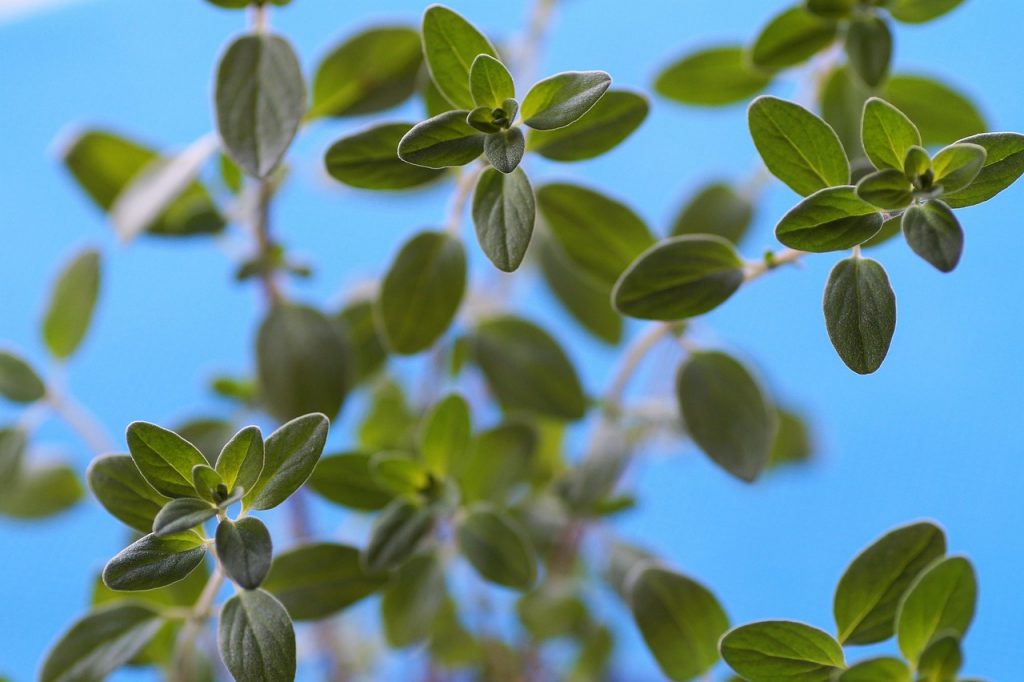Marjoram (Origanum majorana) is one of the best-known culinary herbs, used mainly in fatty dishes and stews because of its intense flavour. Marjoram is closely related to oregano, which is also a spice and herb.
Aphrodite’s spice
It originated in the Mediterranean area and is now mainly grown in Central and Southern Europe, North Africa and Asia.
In its native habitat, marjoram grows mainly in sunny, shallow and loose soil. It is also found in wild form in parts of central Europe.
Marjoram has been known since antiquity. The Arabs used it against drunkenness. The ancient Greeks dedicated the plant to the goddess Aphrodite, as it was then considered a love potion. This was not without reason, given its sedative and tonic properties. From the 16th century onwards, marjoram became known and popular in Europe. First In monastery gardens marjoram was grown by monks, then it was introduced into home gardens.
Ingredients of fresh marjoram – up to 3.5% essential oils
Marjoram is rich in essential oils, but the content of these health-promoting substances can vary widely. The plant can contain up to 3.5% essential oils. Their concentration is affected by climatic conditions, soil type and time of year. In addition to essential oils, marjoram also contains:
flavonoids;
ascorbic acid;
bitter substances;
tannins;
rosemary acid;
glycosides;
vitamin C;
zinc.

Gastronomic uses of fresh marjoram
Spice for soups, game, poultry, fish, stews, pâtés. Can also be added to pasta dishes, and casseroles. It is best fresh but keeps its pleasant aroma even when dried. Mediterranean cuisine usually uses it together with basil and thyme.
Because marjoram has a strong flavour, it is rarely combined with other herbs. In some dishes, aromatic marjoram leaves are harmoniously combined with garlic, parsley or cumin seeds. Unlike many other herbs, marjoram does not lose its aroma when dried. It is used less frequently, but it is recommended to store marjoram in neutral oil (e.g. olive oil). In this form it is suitable for salads and pasta.
Use of fresh marjoram as a medicinal herb
Marjoram is not only a popular spice but also a versatile herb. The plant, like many Mediterranean herbs, contains valuable active ingredients that can alleviate a variety of ailments.
Marjoram has been used for medicinal purposes since ancient times. In medieval herbaria (e.g. Matthioli, Bock), marjoram was recommended mainly for the treatment of mental illnesses and speech disorders. The ground herb marjoram was used, either inhaled through the nose or applied as a poultice to the head. In addition, marjoram was used to treat stomach aches and a number of unspecified female ailments.
Marjoram still plays an important role in natural medicine today. Its healing properties are mainly attributed to its essential oils, as well as to some bitter substances and flavonoids, which have antibacterial, sedative and partially sedative properties.
Marjoram is nowadays used for the following diseases and complaints:
stomach and stomach ache;
general indigestion;
biliary problems;
intestinal complaints;
diarrhoea;
bloating;
loss of appetite;
externally for ulcers and joint pain;
bleeding gums;
inflammation of the mucous membranes of the mouth and nose;
headache;
nervous anxiety;
insomnia;
cough and runny nose;
seasickness.
Marjoram can be used in tea, ointment, pure form in herbal cushions or as a bath additive.
Marjoram tea can be used to treat stomach problems, bloating or colds. About 3 grams of marjoram per cup (200 ml) are needed. It is usually drunk in one or two cups a day.
Marjoram can be used on its own or as an ingredient in herbal steam bath mixtures. This bath helps with colds and can also be used for cosmetic purposes; marjoram helps to cleanse the skin.
Side effects of marjoram
Marjoram should not be used for medicinal purposes for more than two weeks, as frequent and long-term use can lead to headaches. During pregnancy, marjoram, especially the essential oils, should be avoided.
For stomach upsets and colds in young children, marjoram ointment can be used occasionally as a home remedy. In some circumstances, intensive use of marjoram ointment may lead to skin discolouration.
Fries with marjoram
1 kg thin-skinned potatoes
1 bunch of fresh marjoram
5 dkg butter
salt (for gourmets try Maldon salt)
Preparation. Grease a large baking pan, place the potatoes in it, sprinkle with the marjoram leaves and drizzle over the remaining butter, diced. Season with salt. Cover with aluminium foil and bake at 200°C for half an hour, then without foil for about half an hour more, until nicely red. Also delicious with fresh rosemary.
Can oregano be substituted for marjoram?
Oregano is an excellent substitute for marjoram. As oregano is spicier, it is best to use about half as much oregano as marjoram.
Does marjoram taste like oregano?
Marjoram has a milder flavour than oregano , tastes similar to thyme but has a sweeter and stronger smell. It is warm, slightly sharp and slightly bitter.
What is the difference between marjoram and oregano?
Oregano plants have a concentration of the aromatic compound carvacrol, which gives them their flavour. In contrast, marjoram is sweeter because it does not have a high content of carvacrol. Instead, it derives its flavour from a number of aromatic compounds, including sabinene (fresh, woody), terpinene (citrus) and linalool (floral).
Last updated: September 24, 2023


